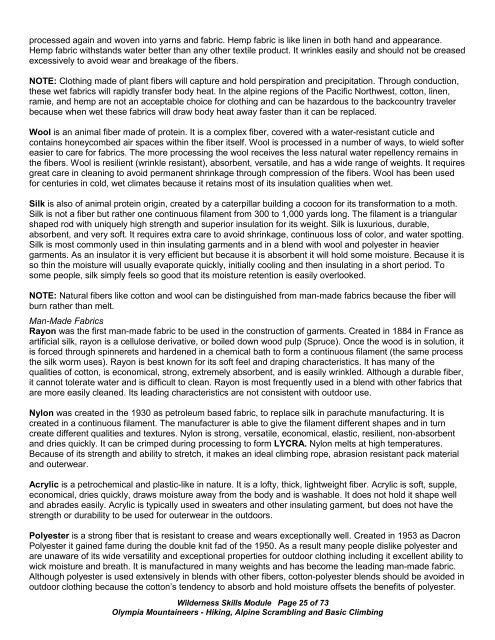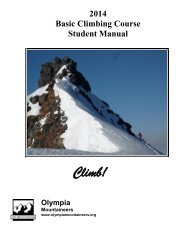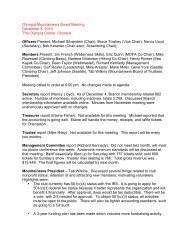Wilderness Skills - Olympia Mountaineers
Wilderness Skills - Olympia Mountaineers
Wilderness Skills - Olympia Mountaineers
You also want an ePaper? Increase the reach of your titles
YUMPU automatically turns print PDFs into web optimized ePapers that Google loves.
processed again and woven into yarns and fabric. Hemp fabric is like linen in both hand and appearance.<br />
Hemp fabric withstands water better than any other textile product. It wrinkles easily and should not be creased<br />
excessively to avoid wear and breakage of the fibers.<br />
NOTE: Clothing made of plant fibers will capture and hold perspiration and precipitation. Through conduction,<br />
these wet fabrics will rapidly transfer body heat. In the alpine regions of the Pacific Northwest, cotton, linen,<br />
ramie, and hemp are not an acceptable choice for clothing and can be hazardous to the backcountry traveler<br />
because when wet these fabrics will draw body heat away faster than it can be replaced.<br />
Wool is an animal fiber made of protein. It is a complex fiber, covered with a water-resistant cuticle and<br />
contains honeycombed air spaces within the fiber itself. Wool is processed in a number of ways, to wield softer<br />
easier to care for fabrics. The more processing the wool receives the less natural water repellency remains in<br />
the fibers. Wool is resilient (wrinkle resistant), absorbent, versatile, and has a wide range of weights. It requires<br />
great care in cleaning to avoid permanent shrinkage through compression of the fibers. Wool has been used<br />
for centuries in cold, wet climates because it retains most of its insulation qualities when wet.<br />
Silk is also of animal protein origin, created by a caterpillar building a cocoon for its transformation to a moth.<br />
Silk is not a fiber but rather one continuous filament from 300 to 1,000 yards long. The filament is a triangular<br />
shaped rod with uniquely high strength and superior insulation for its weight. Silk is luxurious, durable,<br />
absorbent, and very soft. It requires extra care to avoid shrinkage, continuous loss of color, and water spotting.<br />
Silk is most commonly used in thin insulating garments and in a blend with wool and polyester in heavier<br />
garments. As an insulator it is very efficient but because it is absorbent it will hold some moisture. Because it is<br />
so thin the moisture will usually evaporate quickly, initially cooling and then insulating in a short period. To<br />
some people, silk simply feels so good that its moisture retention is easily overlooked.<br />
NOTE: Natural fibers like cotton and wool can be distinguished from man-made fabrics because the fiber will<br />
burn rather than melt.<br />
Man-Made Fabrics<br />
Rayon was the first man-made fabric to be used in the construction of garments. Created in 1884 in France as<br />
artificial silk, rayon is a cellulose derivative, or boiled down wood pulp (Spruce). Once the wood is in solution, it<br />
is forced through spinnerets and hardened in a chemical bath to form a continuous filament (the same process<br />
the silk worm uses). Rayon is best known for its soft feel and draping characteristics. It has many of the<br />
qualities of cotton, is economical, strong, extremely absorbent, and is easily wrinkled. Although a durable fiber,<br />
it cannot tolerate water and is difficult to clean. Rayon is most frequently used in a blend with other fabrics that<br />
are more easily cleaned. Its leading characteristics are not consistent with outdoor use.<br />
Nylon was created in the 1930 as petroleum based fabric, to replace silk in parachute manufacturing. It is<br />
created in a continuous filament. The manufacturer is able to give the filament different shapes and in turn<br />
create different qualities and textures. Nylon is strong, versatile, economical, elastic, resilient, non-absorbent<br />
and dries quickly. It can be crimped during processing to form LYCRA. Nylon melts at high temperatures.<br />
Because of its strength and ability to stretch, it makes an ideal climbing rope, abrasion resistant pack material<br />
and outerwear.<br />
Acrylic is a petrochemical and plastic-like in nature. It is a lofty, thick, lightweight fiber. Acrylic is soft, supple,<br />
economical, dries quickly, draws moisture away from the body and is washable. It does not hold it shape well<br />
and abrades easily. Acrylic is typically used in sweaters and other insulating garment, but does not have the<br />
strength or durability to be used for outerwear in the outdoors.<br />
Polyester is a strong fiber that is resistant to crease and wears exceptionally well. Created in 1953 as Dacron<br />
Polyester it gained fame during the double knit fad of the 1950. As a result many people dislike polyester and<br />
are unaware of its wide versatility and exceptional properties for outdoor clothing including it excellent ability to<br />
wick moisture and breath. It is manufactured in many weights and has become the leading man-made fabric.<br />
Although polyester is used extensively in blends with other fibers, cotton-polyester blends should be avoided in<br />
outdoor clothing because the cotton’s tendency to absorb and hold moisture offsets the benefits of polyester.<br />
<strong>Wilderness</strong> <strong>Skills</strong> Module Page 25 of 73<br />
<strong>Olympia</strong> <strong>Mountaineers</strong> - Hiking, Alpine Scrambling and Basic Climbing




